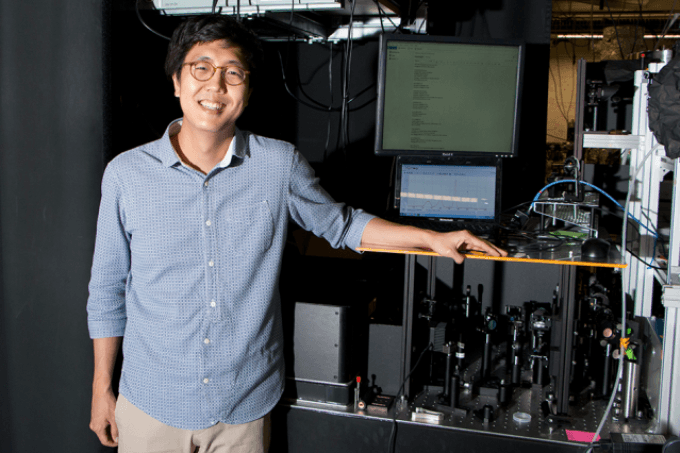Oct 26 2016
 MIT graduate student Changmin Lee stands by an experimental setup that uses light pulses to map the magnetic direction and strength of a buried interface between two exotic materials, bismuth selenide and europium sulfide. (Photo: Denis Paiste/Materials Processing Center)
MIT graduate student Changmin Lee stands by an experimental setup that uses light pulses to map the magnetic direction and strength of a buried interface between two exotic materials, bismuth selenide and europium sulfide. (Photo: Denis Paiste/Materials Processing Center)
The magnetic properties of materials have inspired technologies from traditional recording tape to advanced hard drives over the years. Scientists are continually pushing to develop new applications from magnetic behavior.
Recently, MIT researchers figured out how to use light pulses to map the magnetic direction and strength of a buried interface between two unusual materials, europium sulfide and bismuth selenide.
Very thin layers of these materials formed a sandwich, one material distinguished by electrical conduction only on it surface, and the other by becoming magnetic at very low temperatures. Nuh Gedik, the Lawrence C. (1944) and Sarah W. Biedenharn Career Development Associate Professor of Physics, and graduate student Changmin Lee measured the level of magnetism at the interface of the two materials.
Their method relies on a transformation that occurs at low temperature under an applied magnetic field as powerful red laser light pulses pass via the sample and a small fraction of red light photons combine together to form a single blue light photon with double the energy of one red photon. This transformation, called magnetic second harmonic generation, happens only at low temperatures.
Although these materials are very thin, measuring between 1 and 10 nm, the second harmonic generation method is capable of selectively probing magnetism only at the interface of the europium sulfide and bismuth selenide sample, while disregarding any interference from the bulk of the material. “That’s really the beauty,” Gedik says.
Their findings were published in Nature Communications. Lee conducted the optical measurements and studied the data while Gedik took care of the optical measurements. Co-authors include MIT postdoc Ferhat Katmis, who prepared the thin film samples, and Mitsui Career Development Associate Professor of Physics Pablo Jarillo-Herrero, and Department of Physics senior research scientist Jagadeesh S. Moodera, who supervised the thin film growth.
Their experimental system probed the sample using ultrafast femtosecond laser pulses, changing the orientation of a magnetic field either perpendicular or parallel to the sample, and gathered data on blue light emission from the sample. They gathered data as they rotated the sample through a full circle in relation to the light source. (Unaltered red light was also filtered out.)
Similar to flower petals, six-fold lobes reveal how the intensity of blue light emanating from a thin film of bismuth selenide/europium sulfide varies when the sample is rotated. Calculating this blue light, or second harmonic generation, shows the strength and direction of magnetism buried at the interface between bismuth selenide and europium sulfide.
In addition to being sensitive to magnetism at the interface between the materials, this magnetic second harmonic generation method enables measuring both perpendicular and parallel magnetic directions simultaneously and has the potential for spatial imaging of magnetic domains in the future, Gedik says.
In the research, europium sulfide, a ferromagnetic insulator (FMI), was paired with bismuth selenide, a topological insulator (TI). While the team was able to measure the transformation of light resulting from the interaction with magnetism in their sample, the mechanism is still not entirely understood.
In a ferromagnetic material such as europium sulfide, its magnetic domains typically are haphazardly distributed, with some magnetic regions pointing down, or South, and pointing up, or North. By applying a strong external magnetic field, all of the magnetic regions are oriented in the same direction, which is how the team conducted these investigations.
Here we are just focusing on one part of the sample and measuring the collective magnetization at that point, but eventually we would like to put a [charge-coupled device] after the sample so that we can actually visualize spatially what the magnetic moments are within that spot. When we actually do that, without applying any magnetic field, we will be able to distinguish where all these magnetic moments are aligned.
Changmin Lee, Graduate Student, MIT
The MIT researchers are eager to discover more about a theoretically predicted state known as the “chiral edge state,” which is a 1D current that flows at the 2D interface between bismuth selenide and europium sulfide. In this state, electrons line themselves up according to a property known as spin.
“Our goal is to extend this technique so we can actually visualize what the spin texture looks like at the interface between a ferromagnet and topological insulator, and I think that’s what’s really unique about this technique,” Lee says.
If they are able to successfully pair this technique using a digital recording device, they may be able to detect this unusual conducting state that is thought to exist at the boundary between these two materials, Gedik proposes. This type of a dissipation-less (zero resistance) one-directional current could be helpful for future spintronic device applications.
This research is supported by the STC Center for Integrated Quantum Materials, the Gordon and Betty Moore Foundation EPiQS Initiative, the Division of Materials Research, MIT Center for Materials Science and Engineering, U.S. Department of Energy, and the Office of Naval Research.